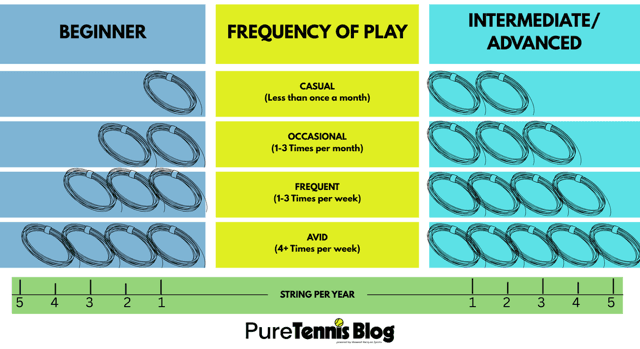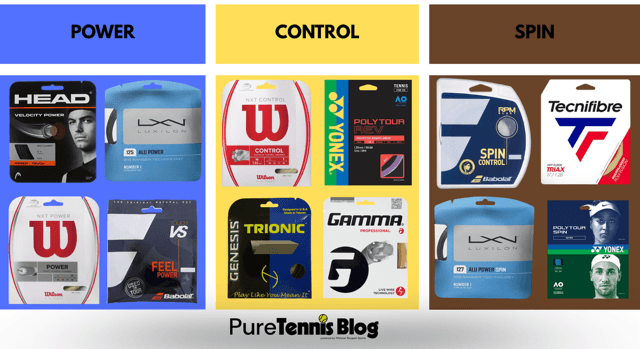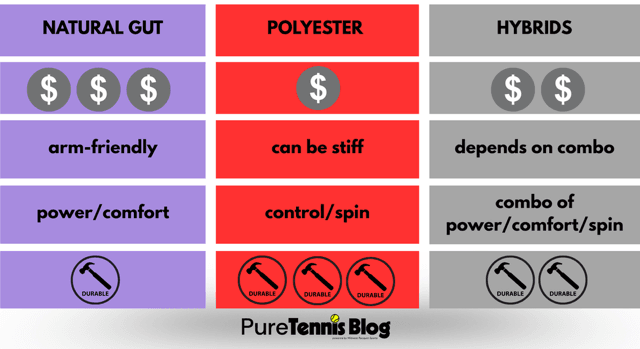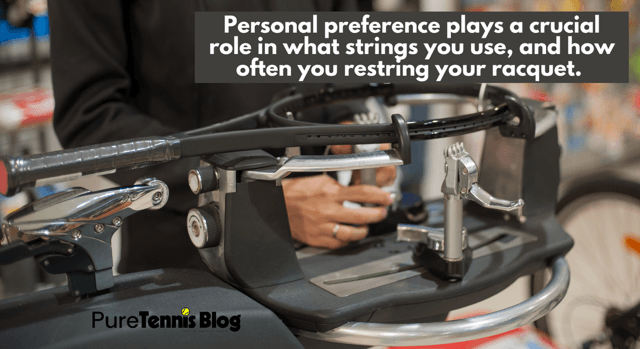Why the Right Tennis Strings Matter
By: Tracy Rolling
Paraphrasing Mark Twain, mind over matter means; if you don’t mind, it won’t matter. Sadly, not enough tennis players realize how much using the right tennis string matters. Tennis strings can give you more power, spin, or control. They’re just as important as your tennis racquet. However, when you use the wrong strings, ones that are loose, frayed, dried-out, or too stiff, it will keep you from performing your best and may even cause injury. To help you learn the advantages of the variety of available strings, we’ve compiled a Q&A for some of the most common questions about tennis strings.
General Tennis String Questions
1. How many types of strings are there?
There are more than 1,000 tennis string suppliers worldwide, however, the most popular brands are: Babolat, Luxilon, Solinco, Wilson, Head, Dunlop, Gamma, Tecnifibre, and Yonex.
2. How often should I restring my racquet?
It depends on how frequently you play, your level, and the conditions you store your racquet. Competitive players who make solid contact with the ball should restring every 4 to 6 weeks, while the more casual player, hitting once a week, might only restring their racquet twice a year. If you store your racquet in areas that experience temperature fluctuations, like a car or the garage, you’ll need to restring more often.
3. How do I know when my strings are dead or it’s time to restring?
When you feel a decrease in your racquet's responsiveness or notice the ball doesn’t have as much “pop” off your racquet, it’s time to restring your racquet. You can also create a maintenance schedule, the same as you would for your car.
String Types and Materials
4. Which strings will give me more power?
Power strings help generate pace so that the ball speed increases and you can hit deeper shots with less effort, even from the baseline. Typically speaking, these are made of materials like natural gut or multifilament. The best-sellers are: Wilson Synthetic Gut Power, Wilson NXT Power, and Luxilon ALU Power.
5. Which strings will give me more control?
Control strings work best for intermediate and advanced players who can produce their own power. Control strings will help place the ball and make it easier to hit their desired target area. Multi-filament and Nylon strings are well suited for control. We suggest: Wilson Hybrid Duo Control, Head RIP Control, Genesis Trionic, and Yonex Poly Tour Rev (available in different colors).
6. How can string add more spin to my game?
Spin strings are used by competitive players wanting to create a “heavy ball,” or a ball that bounces up high, making it difficult for opponents to attack. Spin strings are usually made of polyester and feature contrasting textures designed to enhance spin. Most popular are: Babolat RPM Blast, Kirschbaum Black Shark, Luxilon ALU Power Spin, and Tecnifibre Triax.
Durability and String Tension
7. What is natural gut and why is it so expensive?
Natural gut tennis strings are made from the intestines of sheep. For that reason, they are more expensive, and not as durable as other options. Natural gut offers unmatched power, comfort, and elasticity, plus it’s the most “arm-friendly” of all the string families.
8. Are polyester strings bad for your arm?
Not necessarily. Polyester strings are best known for their durability and control. They’re designed for advanced players who generate their own power. These strings also provide excellent spin, however, when novice players use polyester strings, they will feel a stiffness that requires them to produce their own power and that’s when arm issues can occur.
9. Can I mix string types?
Yes. This approach is how HYBRID strings came to be. Hybrid strings combine two different types of strings, allowing players to take advantage of the benefits of each. For instance, using a polyester string in the mains for control and spin, paired with a nylon string in the crosses for added comfort and power. Former #1 player Roger Federer was famous for his Luxilon/Gut string mix. Hybrids can also be tailored to fit individual play styles and preferences for a customized experience.
Overall String Performance and Feel
10. What tension should I string my racquet at?
Always refer to the racquet manufacturer's suggested tension, located on the inside of the racquet throat. It ranges between 40 and 65 pounds, with a higher tension giving players more control. Racquets strung on the low end will experience more elasticity, therefore giving you more power, a larger sweet spot and more comfort.
11. How does gauge affect performance?
Gauge refers to the string thickness. As a rule of thumb, thinner strings (higher gauge 17-18) offer more spin, better feel, more power, but are less durable. Thicker strings (lower gauge 15-16) provide greater control and are much more resistant to breaking.
12. Is there a “universal string” that works for everyone?
No. Ultimately, your comfort and personal preference plays a crucial role in what strings you use, and how often you restring your racquet.
Closing Remarks
Recognizing the uniqueness each tennis player has with their own play style and comfort level, it's important to pick strings that compliment your game. Don’t be intimidated by how many choices there are. Simply start with a set of strings and keep a journal of your likes and dislikes. This will help you hone in on the right ones. Remember, just like a match, finding the right tennis strings requires preparation, focus, and perseverance. Count on the experts at Midwest Racquet Sports to help you GEAR UP and get your GAME ON!




